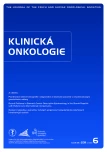Trabectedin Registry
Authors:
K. Kubáčková 1; J. Fínek 2; R. Vyzula 3; M. Zvaríková 3; M. Vočka 4; S. Batko 1; J. Dreslerová 2; P. P. Lazarov 5; M. Lysý 6; Z. Ptáčková 7; V. Benešová 8; Z. Bortlíček 9; V. Kandrnal 9
Authors‘ workplace:
Fakultní nemocnice v Motole, Praha
1; Fakultní nemocnice Plzeň
2; Masarykův onkologický ústav, Brno
3; Všeobecná fakultní nemocnice, Praha
4; Krajská nemocnice Liberec
5; Masarykova nemocnice Ústí nad Labem
6; Fakultní nemocnice Hradec Králové
7; Nemocnice Jihlava
8; Institut biostatistiky a analýz, MU Brno
9
Published in:
Klin Onkol 2011; 24(6): 470-474
Category:
Reports from Clinical Registries
Overview
Backgrounds:
The Yondelis® (trabectedin) project was initiated in January 2011 with the aim to obtain basic epidemiological information on patients with soft tissue sarcomas, standard treatment procedures, and results of trabectedin therapy in routine clinical practice. Expert patronage is provided by the Czech Society for Oncology, CzMA JEP. The project covers a representative sample of Comprehensive Cancer Care centres established to provide systematic treatment to patients with soft tissue sarcoma.
Patients and Methods:
45 patients diagnosed with soft tissue sarcoma were retrospectively included in the database. Median age at the initiation of trabectedin therapy was 51 years (23–72 years). Leiomyosarcoma was the most frequent tumour (35.6%), synovial sarcoma occurred in 13.3% of patients; liposarcoma, peripheral nerve sheath tumours and unspecified sarcomas contributed 6.7% each. 62.2% of sarcomas were larger than 5 cm. Trabectedin was administered in a dose of 1.5 mg/m2 once in 3 weeks. 40% of patients received trabectedin as the 2nd line treatment, 35.6% as the 3rd line, and 34.4% as the 4th line. Results: Median number of administered cycles was 4 (1–10 cycles). Neutropenia (28.9% of patients) and elevated liver enzymes (26.7% of patients) were the most frequent adverse affects. 73.8% of patients terminated the therapy due to disease progression. Treatment response was recorded in 6.6% of patients (complete and partial remission), stable disease in 26.7%, and progression in 53.3%. Median overall survival (95% CI) was 11.7 months (9.6; 13.8), median progression-free survival (95% CI) was 3 months (2.4; 3.6).
Conclusion:
Expert cancer societies have recently recommended trabectedin as the 2nd line palliative treatment for soft tissue sarcomas with documented effectiveness, particularly in liposarcomas and leiomyosarcomas, and good safety profile.
Key words:
soft tissue sarcoma – chemotherapy – trabectedin – treatment
Submitted:
18. 7. 2011
Accepted:
8. 11. 2011
Sources
1. Carter NJ, Keam SJ. Trabectidin: a review of its use in soft tissue sarcoma and ovarian cancer. Drugs 2010; 70(3): 355–376.
2. Chuk MK, Balis FM, Fox E. Trabectedin. Oncologist 2009; 14(8): 794–799.
3. Schöffski P, Dumez H, Wolter P et al. Clinical impact of trabectedin (ecteinascidin-743) in advanced/metastatic soft tissue sarcoma. Expert Opin Pharmacother 2008; 9(9): 1609–1618.
4. Blay JY, von Mehren M, Samuels BK et al. Phase I combination study of trabectidin and doxorubicin in patients with soft-tissue sarcoma. Clin Cancer Res 2008; 14(20): 6656–6662.
5. Clark MA, Fisher C, Judson I et al. Soft-tissue sarcomas in adults. N Engl J Med 2005; 353(7): 701–711.
6. Hogendoorn PC, Collin F, Daugaard S et al. Changing concepts in the pathological basis of soft tissue and bone sarcoma treatment. Eur J Cancer 2004; 40(11): 1644–1654.
7. Veselý K. Histopatologická diagnostika nádorů měkkých tkání. Onkologie 2010; 4(5): 293–296.
8. Cormier JN, Pollock RE. Soft tissue sarcomas. CA Cancer J Clin 2004; 54(2): 94–109.
9. Dušek L, Mužík J, Kubásek M et al. Epidemiologie zhoubných nádorů v České republice [online]. Masarykova univerzita 2005 [cit. 2011-4-27]. Dostupný z http://www.svod.cz.
10. Yondelis Summary of Product Characteristics SPC. EMA 2010. Available from: http://www.ema.europa.eu/docs/cs_CZ/document_library/EPAR_Product_Information/human/000773/WC500045832.pdf.
11. Demetri GD, Chawla SP, von Mehren M et al. Efficacy and safety of trabectedin in patients with advanced or metastatic liposarcoma or leiomyosarcoma after failure of prior anthracyclines and ifosfamide: results of a randomized phase II study of two different schedules. J Clin Oncol 2009; 27(25): 4188–4196.
12. Vyzula R et al. Zásady cytostatické léčby maligních onkologických onemocnění. 13. vydání. Brno: Masarykův onkologický ústav 2011.
13. Casali PG, Blay JY. ESMO/CONTICANET/EUROBONET Consensus Panel of Experts. Soft tissue sarcomas: ESMO Clinical Practice Guidelines for diagnosis, treatment and follow-up. Ann Oncol 2010; 21 (Suppl 5): v198–v203.
14. Schöffski P, Taron M, Jimeno J et al. Predictive impact of DNA repair functionality on clinical outcome of advanced sarcoma patients treated with trabectedin: a retrospective multicentric study. Eur J Cancer 2011; 47(7): 1006–1012.
15. Ray-Coquard I. An increasing role for trabectidin in gynecological cancers: efficacy in uterine sarcomas. Int J Gynecol Cancer 2011; 21 (10 Suppl 1): S3–S5.
16. Scurr M. Histology-driven chemotherapy in soft tissue sarcomas. Curr Treat Options Oncol 2011; 12(1): 32–45.
Labels
Paediatric clinical oncology Surgery Clinical oncologyArticle was published in
Clinical Oncology

2011 Issue 6
Most read in this issue
- Castleman Disease
- Long Term Follow up of Eosinophilic Granuloma of the Rib
- Trabectedin Registry
- Predictive Values of the Ultrasound Parameters, CA-125 and Risk of Malignancy Index in Patients with Ovarian Cancer
